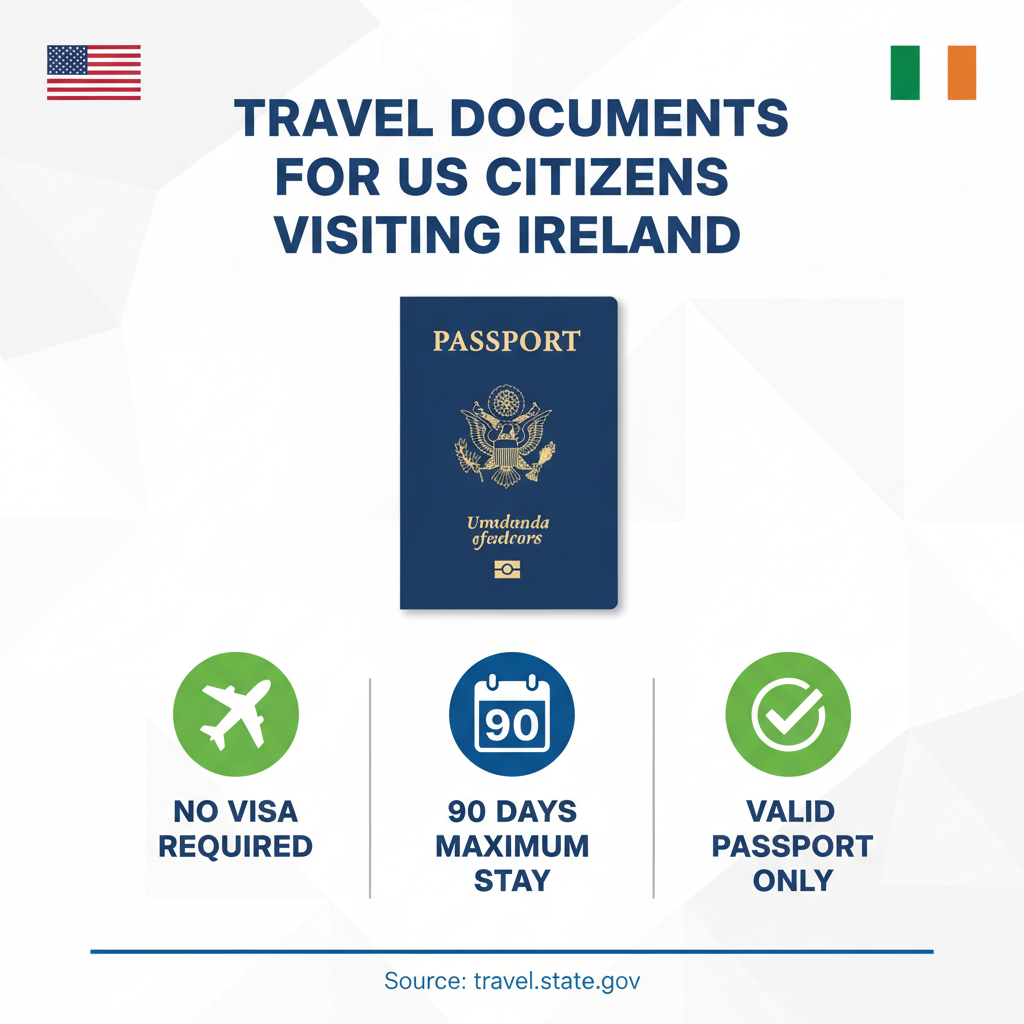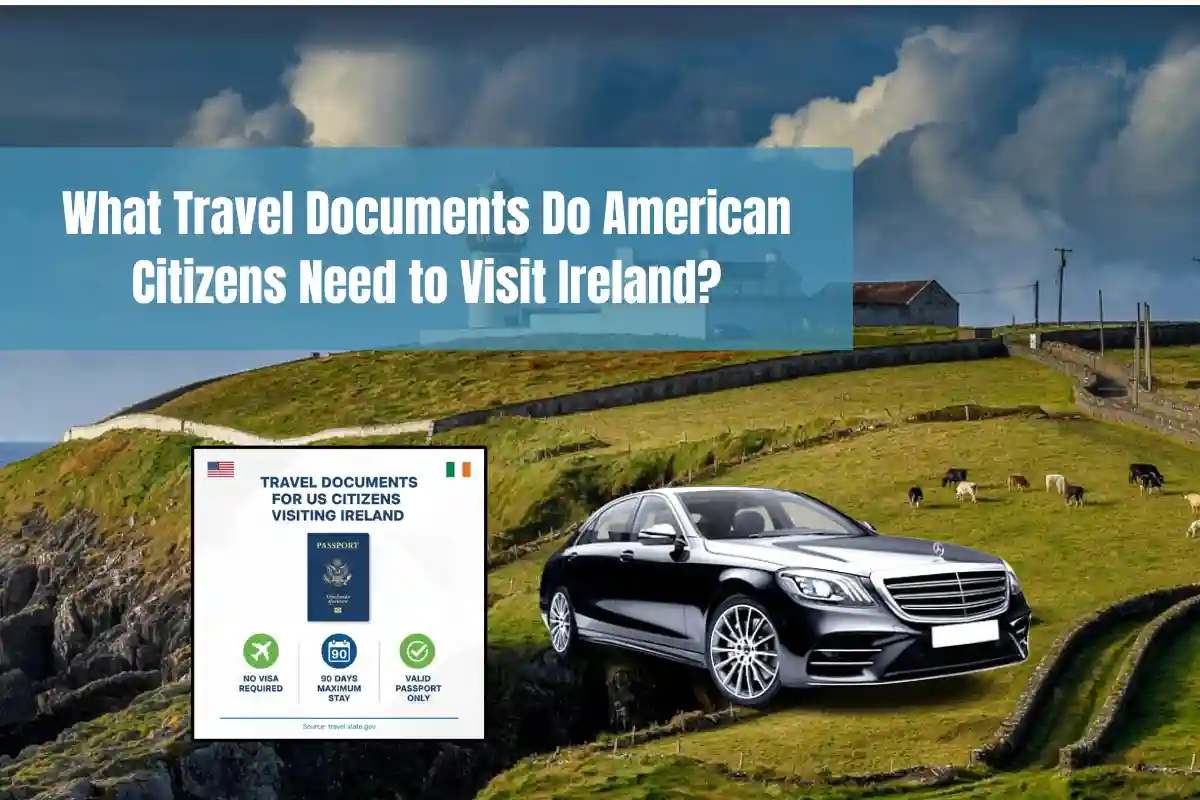So, you’re dreaming of Private Tours of Ireland. I get it. The endless green hills, the dramatic cliffs of Moher, the cozy pubs with live music that pulls you in… it’s a place that feels like a storybook. But before you can be sipping a pint in Dublin or tracing the Ring of Kerry, there’s that small but crucial step: getting your documents in order. It’s the least romantic part of travel planning, but getting it right is the key to a stress-free start to your adventure.
The rules can feel a bit confusing, especially with all the talk about different countries, new travel authorizations, and what applies where.
Let’s break it down, step by step, so you know exactly what to pack in that document folder. Think of this as your friendly guide to getting through immigration with a smile, ready to start your Irish journey.
The Quick Answer
For a tourist trip to the Republic of Ireland lasting up to 90 days, U.S. citizens only need a valid U.S. passport. No visa is required. However, if you plan to visit Northern Ireland (which is part of the UK), you will also need a UK Electronic Travel Authorisation (ETA).
Key Takeaways at a Glance
If you’re short on time, here are the absolute must-knows for your trip to the Emerald Isle:
- Valid Passport is Essential: Your U.S. passport is the single most important document. It must be valid for the entire duration of your stay in the Republic of Ireland.
- No Visa for Tourists: For tourism or business trips up to 90 days in the Republic of Ireland, U.S. citizens do not need a visa.
- Know Your Irelands: The Republic of Ireland and Northern Ireland are two different countries with different entry rules.
- Northern Ireland requires an ETA: Since Northern Ireland is part of the United Kingdom, U.S. citizens need to apply for a UK Electronic Travel Authorisation (ETA) online before traveling there, even if crossing the land border from the Republic.
- Be Prepared for Questions: An immigration officer may ask for proof of funds, your accommodation details, and a return ticket to ensure you plan to leave within the 90-day limit.
The Core Requirement: Your U.S. Passport
Let’s start with the non-negotiable: your passport. This little blue book is your golden ticket to Ireland. Without a valid one, your trip ends before it even begins. But “valid” can mean a few different things, so let’s get specific.
Passport Validity: The “Duration of Stay” Rule
Unlike some European countries in the Schengen Area that require your passport to be valid for three to six months beyond your planned departure date, Ireland has a more relaxed rule. According to the U.S. Department of State, your passport only needs to be valid for the duration of your stay.
However, and this is a big “however,” I always advise travelers to err on the side of caution. What if your trip gets unexpectedly extended? A delayed flight, a sudden decision to stay a few extra days… life happens. Having a passport with at least six months of validity remaining is a solid travel habit. It covers you for any unforeseen changes and is a requirement for many other countries, so it just makes international travel smoother.
Blank Pages and Passport Condition
Your passport needs at least one completely blank page for the Irish entry stamp. This is the stamp the immigration officer will place in your passport upon arrival. It’s your official welcome! Also, make sure your passport is in good condition. Significant damage, like a torn cover, water damage, or a separated photo page, could lead to you being denied boarding on your flight or entry into the country.
Visa? Not for a Holiday! The 90-Day Rule Explained
Here’s some great news: for American citizens, Ireland is incredibly welcoming. Thanks to a visa waiver program, if you’re traveling for tourism or certain business purposes, you can enter and stay in the Republic of Ireland for up to 90 days without a visa.
When you arrive at the airport in Dublin or Shannon, you’ll go through immigration control. The officer will stamp your passport, granting you “permission to land.” While it’s usually a straightforward process, they have the final say. To ensure a smooth entry, be ready to answer a few simple questions about your trip and have some documents handy, just in case. They might ask about:
- The purpose of your visit: (e.g., “I’m here for a two-week vacation to explore the west coast.”)
- How long do you intend to stay? Your answer should align with your return flight.
- Where you’ll be staying: Having the address of your first night’s hotel or rental is a good idea.
- Proof of sufficient funds: While rarely asked, it’s wise to be able to show you can support yourself during your trip (e.g., via a credit card or bank statement).
- A return or onward ticket: This is the most common request, as it proves your intention to leave Ireland within the 90-day limit.
Think of it less as an interrogation and more as a friendly chat to confirm you’re a genuine tourist. A smile and clear, honest answers go a long way.

The Crucial Distinction: Republic of Ireland vs. Northern Ireland
This is where many travelers get tripped up, and it’s the most important update for 2025. The island of Ireland is home to two different countries: the Republic of Ireland (an independent EU member state) and Northern Ireland (part of the United Kingdom).
While there’s no physical border with checkpoints between them (thanks to the Common Travel Area), they have different entry requirements for non-EU/UK citizens. Driving from Dublin to Belfast feels like crossing a state line, but from an immigration perspective, you’re entering a new country.
Visiting the Republic of Ireland: Simple and Straightforward
As we’ve covered, for a U.S. citizen flying into Dublin (DUB) or Shannon (SNN), all you need is your valid passport for a stay of up to 90 days.
Visiting Northern Ireland: The New UK ETA Requirement
This is the game-changer. To visit Northern Ireland, home to Belfast, the Giant’s Causeway, and many Game of Thrones filming locations, you must have a UK Electronic Travel Authorisation (ETA). This is a new requirement for visa-exempt nationals, including U.S. citizens.
- What is it? An ETA is a digital permission to travel to the UK. It’s not a visa, but it is mandatory.
- How do you get it? You apply online or via a mobile app before you travel. The process is quick, and approval is usually linked electronically to your passport within a few days.
- When do you need it? You need it to enter any part of the UK, including Northern Ireland. This applies whether you fly directly into Belfast or drive across the land border from the Republic of Ireland.
- Cost and Validity: The fee is currently £10, and the ETA is valid for two years, allowing multiple visits. You can find the official application portal on the UK Government website.
Here’s a simple table to make it crystal clear:
| Requirement | Republic of Ireland | Northern Ireland |
|---|---|---|
| Primary Document | Valid U.S. Passport | Valid U.S. Passport |
| Visa Required? (for tourism < 90 days) | No | No |
| Electronic Authorisation | Not required | Yes, UK ETA is mandatory |
| Passport Validity Rule | Valid for duration of stay | Valid for duration of stay |
Beyond the Passport: Other Documents to Pack
While your passport (and ETA for the North) are the only mandatory documents, a smart traveler always carries a few other items to make the journey smoother.
Driving in Ireland: U.S. License & IDP
Planning to rent a car and drive those winding coastal roads? You can legally drive in Ireland for up to one year with a valid U.S. driver’s license. However, some rental car companies may prefer or require you to also have an International Driving Permit (IDP). An IDP is simply a translation of your license into multiple languages and can be easily obtained from AAA before your trip. It’s cheap peace of mind, especially if you get pulled over in a rural area.
Proof of Travel Insurance
Travel insurance isn’t required for entry, but I can’t recommend it enough. Your U.S. health insurance plan (including Medicare) will likely not cover you in Ireland. Travel insurance protects you from massive medical bills in an emergency and can also cover trip cancellations, lost luggage, and rental car issues. Keep a digital and physical copy of your policy information with you.
Itinerary and Accommodation Bookings
As mentioned, the immigration officer might ask about your plans. Having a printout or saved emails of your first few nights’ accommodation and your return flight confirmation can quickly and easily demonstrate your intentions as a tourist. It just shows you’re organized and have a clear plan.
Visual Summary: Ireland vs. Northern Ireland Entry

A quick visual guide to the key documents needed for your trip.
Frequently Asked Questions (FAQs)
1. Is Ireland part of the Schengen Area?
No, the Republic of Ireland is not part of the Schengen Area. It maintains its own immigration policies. This is why you will go through passport control when arriving from a Schengen country, and why the passport validity rules are different.
2. What happens if I want to stay in Ireland for longer than 90 days?
If you wish to stay longer than 90 days, you must apply for permission from the Irish Immigration Service *before* your current 90-day permission expires. This is not guaranteed and requires a valid reason, such as enrolling in a study program. Overstaying your permission is a serious offense.
3. Does my child need a passport to travel to Ireland?
Yes, every U.S. citizen, regardless of age, must have their own valid passport to travel to Ireland. If a child is traveling with only one parent or with non-parent guardians, it’s also highly recommended to carry a signed letter of consent from the non-traveling parent(s).
4. Can I work in Ireland on a tourist permission?
No. The 90-day visa-free entry is for tourism or limited business meetings only. You are not permitted to take up employment. To work in Ireland, you must secure a proper work permit/visa before you travel.
A Final Thought Before You Go
Getting your documents ready for Ireland is, for the most part, wonderfully simple. A valid passport is your key to the Republic. The main thing to remember for 2025 and beyond is that little extra step—the UK ETA—if your journey takes you north. A few minutes of online prep can save you a world of hassle. Now that the paperwork is sorted, you can get back to the fun part: planning which ancient castles to explore and which cozy pubs to call your own for an evening. Have an amazing trip!





 No products in the cart.
No products in the cart.
Comments (1)
Comments are closed.